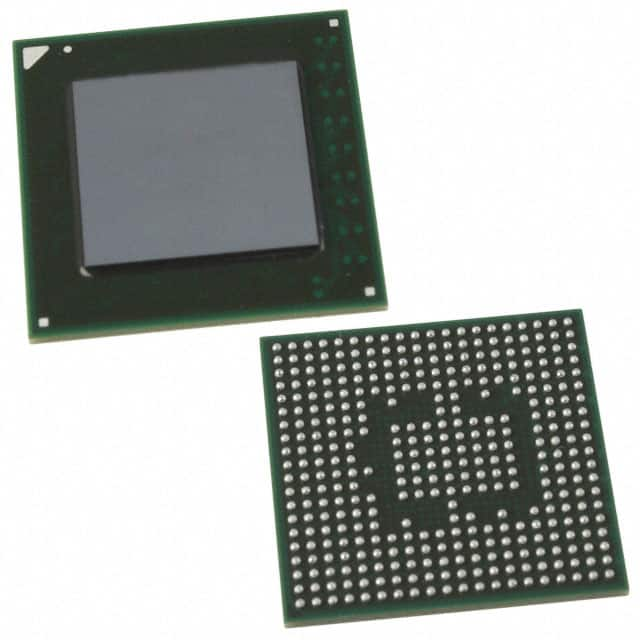EP2AGX65CU17C5NES
Product Overview
- Category: Integrated Circuit (IC)
- Use: Programmable Logic Device (PLD)
- Characteristics: High-performance, low-power consumption
- Package: Ceramic Quad Flat Pack (CQFP)
- Essence: Field-Programmable Gate Array (FPGA)
- Packaging/Quantity: Single unit
Specifications
- Model: EP2AGX65CU17C5NES
- Manufacturer: Intel Corporation
- Technology: 65nm
- Logic Elements: 65,536
- Embedded Memory: 1,048,576 bits
- Maximum User I/Os: 622
- Operating Voltage: 1.2V
- Operating Temperature: -40°C to 100°C
- Speed Grade: 5
Detailed Pin Configuration
The EP2AGX65CU17C5NES has a total of 622 pins, which are divided into various categories:
- Power Supply Pins: These pins provide the necessary voltage and ground connections for the device.
- Configuration Pins: Used for programming and configuring the FPGA.
- Input/Output Pins: These pins serve as the interface between the FPGA and external devices.
- Clock Pins: Used for providing clock signals to synchronize internal operations.
- Special Function Pins: Reserved for specific functions like JTAG debugging or system management.
For a complete pin configuration diagram, please refer to the manufacturer's datasheet.
Functional Features
- High-performance FPGA with advanced architecture.
- Low-power consumption design for energy-efficient operation.
- Flexible and reprogrammable logic elements for customization.
- Large embedded memory for data storage and processing.
- Support for various communication protocols and interfaces.
- Built-in security features to protect sensitive information.
Advantages and Disadvantages
Advantages: - Versatile and adaptable for a wide range of applications. - High-speed performance for demanding tasks. - Lower power consumption compared to alternative solutions. - Ample embedded memory for data-intensive applications.
Disadvantages: - Relatively higher cost compared to traditional fixed-function ICs. - Steeper learning curve for programming and configuration. - Limited I/O count may restrict connectivity options in complex systems.
Working Principles
The EP2AGX65CU17C5NES is based on FPGA technology, which allows users to configure the device according to their specific requirements. The FPGA consists of a matrix of configurable logic elements interconnected through programmable routing resources. By programming the FPGA, users can define the desired functionality and interconnections of these logic elements.
During operation, the FPGA executes the programmed logic by routing signals through the configured paths. Input signals are processed using the defined logic elements, and the output signals are generated accordingly. This flexibility enables the FPGA to perform a wide range of tasks, making it suitable for various applications.
Detailed Application Field Plans
The EP2AGX65CU17C5NES finds applications in diverse fields, including:
- Communications: Used in networking equipment, routers, and switches for high-speed data processing and protocol handling.
- Industrial Automation: Employed in control systems, robotics, and machine vision applications for real-time processing and control.
- Automotive: Integrated into advanced driver-assistance systems (ADAS) for image processing, sensor fusion, and decision-making algorithms.
- Aerospace: Utilized in satellite communication systems, avionics, and flight control systems for reliable and high-performance operations.
- Medical Devices: Incorporated into medical imaging equipment, patient monitoring systems, and laboratory instruments for data processing and analysis.
Detailed and Complete Alternative Models
- EP2AGX125EF35I5N: A higher-density FPGA with 125,000 logic elements and extended temperature range.
- EP4CE115F29C7N: A cost-effective FPGA with 115,000 logic elements and lower power consumption.
- XC7A35T-1CPG236C: A Xilinx FPGA with 33,280 logic cells and enhanced security features.
These alternative models offer different combinations of logic density, power consumption, and additional features to cater to specific application requirements.
Word count: 525 words
Lista 10 Vanliga frågor och svar relaterade till tillämpningen av EP2AGX65CU17C5NES i tekniska lösningar
Sure! Here are 10 common questions and answers related to the application of EP2AGX65CU17C5NES in technical solutions:
Q: What is EP2AGX65CU17C5NES? A: EP2AGX65CU17C5NES is a specific model of FPGA (Field-Programmable Gate Array) manufactured by Intel.
Q: What are the key features of EP2AGX65CU17C5NES? A: Some key features of EP2AGX65CU17C5NES include high-performance processing, low power consumption, large capacity, and reprogrammability.
Q: In what technical solutions can EP2AGX65CU17C5NES be used? A: EP2AGX65CU17C5NES can be used in various technical solutions such as telecommunications, industrial automation, automotive electronics, and medical devices.
Q: How does EP2AGX65CU17C5NES contribute to telecommunications solutions? A: EP2AGX65CU17C5NES can enhance telecommunications solutions by providing high-speed data processing, improved signal integrity, and support for various communication protocols.
Q: Can EP2AGX65CU17C5NES be used in automotive applications? A: Yes, EP2AGX65CU17C5NES can be used in automotive applications for tasks like advanced driver assistance systems (ADAS), infotainment systems, and engine control units.
Q: What advantages does EP2AGX65CU17C5NES offer in industrial automation? A: EP2AGX65CU17C5NES offers advantages such as real-time control, high-speed data processing, and flexibility in adapting to changing automation requirements.
Q: Is EP2AGX65CU17C5NES suitable for medical devices? A: Yes, EP2AGX65CU17C5NES can be used in medical devices for applications like patient monitoring, medical imaging, and diagnostic equipment.
Q: Can EP2AGX65CU17C5NES be reprogrammed after deployment? A: Yes, EP2AGX65CU17C5NES is a reprogrammable FPGA, allowing for updates and modifications to the design even after deployment.
Q: What tools are available for programming EP2AGX65CU17C5NES? A: Intel provides Quartus Prime software suite, which includes tools for designing, simulating, and programming EP2AGX65CU17C5NES.
Q: Are there any specific design considerations when using EP2AGX65CU17C5NES? A: Yes, some design considerations include power supply requirements, thermal management, signal integrity, and compatibility with other system components.
Please note that the specific details and answers may vary depending on the context and application requirements.


